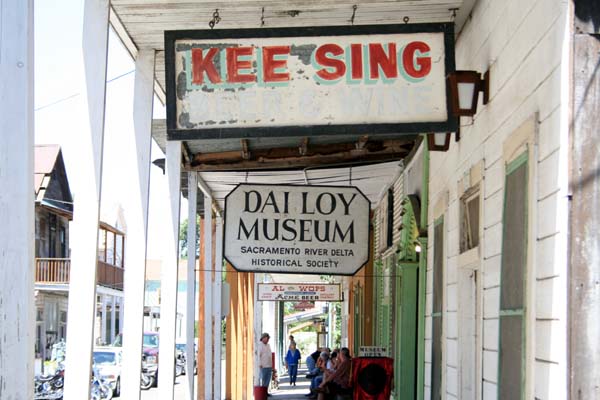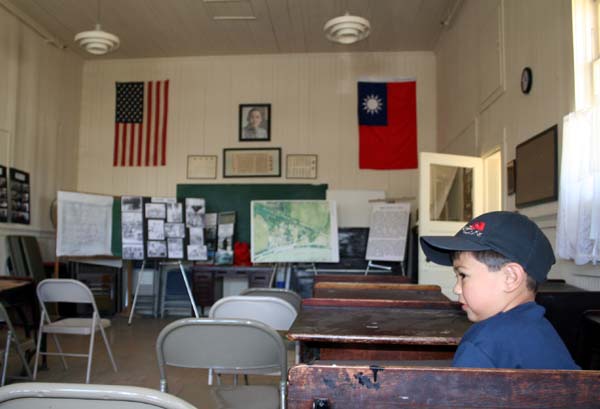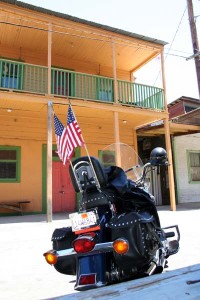
Water Ghosts and a Roadtrip to the Last Rural Chinatown
A few years ago, our family attended a wedding on the Sacramento River Delta. While looking up information for the area, I found out that very close to where we were staying was the the last remaining rural Chinatown. Nestled again the levee of the Sacramento River is the tiny town of Locke, California.
The whole Delta area is like a trip back in time — or to the Mississippi River– with it’s wide open farmland, one-stoplight towns, and system of drawbridges. Turning down the one street that makes up the old business district of Locke is like a trip-within-a-trip (take that, Hunter S. Thompson!) Leaning wooden buildings, many with second story porches, give you a feeling for what it must have been like back in the early 1900s.
There is an old Chinese school, where the American flag hangs next to the Taiwanese flag. Wait? There were no immigrants from Taiwan back in the day. Then, it occurs to me. Cantonese immigrants came to California well before the Communist Revolution, back when it was still the Republic of China.
There is a tiny gift shop, the Dai Loy gambling house (which has now been turned into a museum), and a Chinese restaurant.
A visitor’s center run by the California State Parks system sits at one end of town, but it was not open during our first visit or our return a year later. Less than 80 people currently live in the old homes just off of Main Street.
The town of Locke captured my eye and my imagination. I wondered what it was like back in the day, before the buildings were creaking and leaning — or were they always that way? My mind raced with a thousand starting points for fictional stories.
Soon after our trip, I heard about Shawna Yang Ryan’s novel Water Ghosts. Ryan is a Hapa Taiwanese-American , and this fantasy features– yes, ghosts–and a main character who is half-Chinese. For a full review, read Terry Hong’s review of Water Ghosts on Smithsonian BookDragon.
Also, if you’re interested in non-fiction and beautiful photography, check out Bitter Melon: Inside California’s Last Rural Chinese Town by Jeff Gillenkirk and James Motlow.
A version of this piece also appears on Open Salon.




What a wonderful piece! I lived in Sacramento for a few years, while working in the State Senate.
I love that you went looking for this historical treasure. These photos are wonderful! They also set my mind racing with images of fictional stories that could’ve been, might’ve been. Were there Chinese cowboys? Riding on horses? I wonder…Fascinating…thank you for sharing! I will look for Water Ghosts at my library. You have definitely sparked my imagination :)
So interesting, I didn’t know this rural Chinatown existed. Fascinating!
Christina– It’s incredible that this place is less than an hour away from downtown Sacramento, yet it’s like being in a different place and time.
Jen– We can only imagine what life was like! Let me know if you read the book.
Bicultural Mama– Even though my family immigrated to America much more recently than the residents of this town, the history is something we shouldn’t forget.
Thanks for reading!
I’ll be asking my partner if he will end making a cycling bike trip into this area to take some photos for me. Yea, he has plans to solo cycle from Canada. (He has done this before… )
If you /anyone travels into Canada, we have some Chinese-Canadian history and Japanese-Canadian history in obvious big cities like Vancouver & Toronto. But also buried in the interior mountain areas of British Columbia in the towns of: Yale, Denver, etc.
Here is a blog post with photos of permanent outdoor art across Canada that memorialize the effort and sacrifice of the Chinese railway workers…and Canadian war veterans (we got to vote after the WWII. How was the U.S. in this area?)
http://cyclewriteblog.wordpress.com/2010/11/04/outdoor-art-work-as-a-thread-of-national-history-across-canada-monuments-to-chinese-canadian-railway-workers/ I’ve lived in all 3 featured cities, so I have the benefit of writing about this art from several different angles.
Great to know there are tributes to Chinese railway workers in Canada. I find it so sad that the contributions of early Asian immigrants –and the injustices against them– are largely forgotten. I’m going to check out your post!